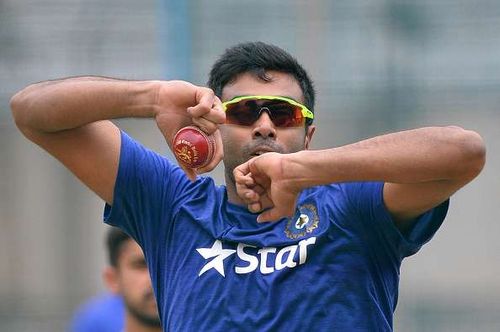
Analysing Ravichandran Ashwin's performances on pitches which are not dust bowls

To say that Ravichandran Ashwin, the gangly Chennai-born off-spinner has been an asset for the Indian cricket team, would be a definite understatement. Having entered into the public’s reckoning through the IPL in 2010, Ashwin has since risen up the ranks swiftly and is now India’s frontline spinner across all formats of the game. One of the crucial aspects that has contributed to his success, has been his control on his off-spinning deliveries, which has helped keep his economy rate healthy, whilst allowing him to take wickets.
Ashwin is currently set to feature in a four-Test series against the West Indies later this month, on the back of quite a disappointing IPL season for both him and his team (Rising Pune Supergiants). Much of Ashwin’s success with the ball has come in Asia, which isn’t surprising, taking into consideration the fact that wickets prepared in the subcontinent are made to favour turn.
The term ‘dust bowl’ refers to pitches that are allowed to dry to a great extent, causing the surface to crack, then crumble and become dusty as play progresses. This hugely favours spin bowlers who can obtain excellent traction on the surface and spin the ball a long way. For a spinner who grew up playing much of his cricket in the dusty turfs of Chennai, Ashwin seems more at home in such pitches, than on hard or grassy ones.
Let’s first take a look at Ashwin’s Test bowling stats outside the Asian continent, where pitches are greener, harder and flatter. Ashwin’s overall figures read 176 wickets in 32 games with a healthy average of 25.39 and an economy of just 2.90. But the moment he leaves the Asian continent, his numbers take a beating.
Ashwin outside Asia
Countries outside Asia seldom prepare dust bowls, and prefer hard, dry and grassy pitches. So a look at Ashwin’s stats outside Asia should be a crucial parameter in analysing his performances on non-dust bowl wickets. In his 9 matches (14 innings) outside of Asia, Ashwin has managed a mere 24 wickets. His average in the continents of Europe, Africa and Oceania combined is 56.58, more than double his average in Asia. His economy also rises to 3.25.
Another noteworthy point is that not a single one of Ashwin’s 16 5-wicket hauls have come outside the subcontinent. In Australia, Ashwin’s figures are far from exemplary. His six matches down under have yielded a paltry 10 wickets at a poor average of 54.71, and an economy of 3.38. Lady luck refused to smile upon the Chennai-lad in England as well, as he managed only 3 wickets in 2 matches. The absolute low point however, was South Africa (Johannesburg), where Ashwin played one match, and went wicket-less in both innings.
Having seen Ashwin’s dismal run of form outside Asia, here’s a look at his performances within the continent.
Ashwin in Asia
Let’s start with Sri Lanka, known usually for preparing dust bowls that aid spinners massively. Ashwin has played in one match apiece at three Sri Lankan stadiums, namely, the PSS (P Sara Oval), the SSC in Colombo, and the treacherous Galle. Here too, we clearly see that Ashwin simply fails to mirror his dust bowl performances on hard wickets. The flaky minefield at Galle was ideal for Ashwin, who grabbed a ten-wicket haul at a magnificent average of 16.00.
The PSS pitch often resembles an Australian or South African pitch rather than a typical sub-continent track in that it has far more bounce than many Sri Lankan pitches, and offers more assistance to pace bowlers. Here, Ashwin enjoyed decent success, picking up 7 wickets at an average of 16.85. The reversal in fortunes came at the damp SSC pitch, where Ashwin could only bag 4 wickets, at a slightly high economy of 3.64.
The slow, damp Fatullah wicket in Bangladesh wasn’t exactly a dust bowl, but Ashwin did well, with 5 wickets in the only completed Bangladesh innings. The match was unfortunately drawn due to bad weather.
In India, the three most prominent dust bowls are incidentally the three grounds where Aswhin has reaped maximum rewards; Chennai, Delhi and Nagpur. In his only Test in Chennai, Ashwin took an astonishing 12 wickets, at an average of 16.50. Nagpur has also been a favoured hunting ground for him, with 15 wickets in 2 matches at an average of 17.50. His three Tests at the Kotla has yielded him 23 wickets at a good average of 14.21.
The dry and cracked Hyderabad pitch has also proved his ally. Ashwin scalped 18 wickets in his 2 matches there, with a splendid average of 10.50. He was at his weakest at Ahmedabad against England, which was surprising, as the wicket was described as ‘powdery’ and did a lot for the spinners. Conversely, in the hard, batsman-friendly Chinnaswamy stadium, Ashwin returned 10 wickets in 2 matches at a fairly good average of 22.10.
Again, he enjoyed a fair bit of success in both Mohali and Mumbai, neither of which can be considered dust bowls, with 12 wickets in 2 games at the former and 18 wickets in 3 games at the latter. The green top at the Eden Gardens in Kolkata caused Ashwin some trouble, as he managed only 14 wickets in 3 matches at an average of 35.57, again establishing his faltering confidence on bouncy tracks.
Here’s a summary of these numbers in a simplified form:
| In Asia | Outside Asia | |
| Matches | 23 | 9 |
| Innings | 45 | 14 |
| Wickets | 152 | 24 |
| Average | 20.47 | 56.58 |
| Economy | 2.77 | 3.25 |
| 5-Wicket Hauls | 16 | 0 |
| MOTM Awards | 4 | 0 |
| MoS Awards | 5 | 0 |
These facts and figures are indicative of a few things. Firstly, Ashwin has had a hard time adapting to seam-friendly tracks, especially overseas. This could well be attributed to the lack of turn and the predictable bounce on such turfs. Secondly, familiarity plays a vital role in Ashwin’s bowling figures; he has had good days at the Chinnaswamy, Mohali and Wankhede, which are typically a batsman’s paradise.
This isn’t the case for any ground outside of Asia, owing to his lack of familiarity. In all, Ashwin has his work cut out for him. The road ahead isn’t an easy one, and Ashwin needs to work on his performances overseas – possibly come up with some variations to bamboozle batsmen on hard pitches. Adapting to seam-friendly conditions overseas is the only way Ashwin can cement his name amongst the greats of the game.